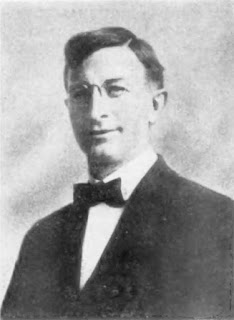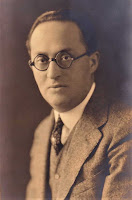Arthur A. Nelson is known as the author of one single work, a four part serial "The Adventurers" which first appeared in the magazine Adventure from January through April 1915, and was collected in book form under the title Wings of Danger (New York: Robert M. McBride & Company, [September] 1915). The story is a better-than-most lost race novel (clearly influenced by H. Rider Haggard), but not without its problems, and E.F. Bleiler accurately described it as "well-written pulp adventure, but cliched and disorganized in structure and incident." In the novel, a political race to claim land in East Africa for the English (led by pro-colonialist Cecil Rhodes) or by the Belgians (on order from the infamous King Leopold) brings about the discovery a lost race of ancient Norse descendants. The conflicts turn upon various love interests. The only hint about the author's identity occurs in the blurb for the story on the contents pages of the January issue of Adventure, where it refers to him as "a business man in a responsible position"--which isn't much to go on.
But the author himself proved very elusive, until a short profile, "Fascinating Story by a Type-Writer Man," was discovered in the December 1914 issue of Office Appliances, where it was revealed that Nelson was then the Advertising Manager of the Royal Typewriter Company. The profile includes the same photograph of Nelson as is found in the Autograph Edition of Wings of Danger, as well as a number of tantalizing if imprecise details:
He is the writer of the advertisements used by the Royal company in its last two advertising campaigns, introducing the new Royal Master Model No. 10, and promoting the development of the Royal business.
He won his way to his present position through the company's merit system. Starting as a salesman for the Royal . . . he was connected with one of the offices in the West. His good work as a salesman and his letters to the company upon matters of business led to his appointment as editor of the Royal Standard, the company's house organ. The excellence of his work in that capacity won for him his present position as advertising manager.
Arthur Nelson is one of the "Western brand of New Yorkers." He is of an adventurous disposition, and has spent much time in hunting and fishing in the woods of northern Michigan. He made good friends with the Ojibwa Indians, and learned to speak their language well, Years ago he was a police reporter on a metropolitan newspaper in the West; and city editor of a Michigan daily. All the while he utilized his spare time writing fiction and enjoying the unusual experience of selling everything he wrote. A number of his earlier stories were sold to the Frank A. Munsey people, and a serial to Street and Smith.*
The serial rights to "The Adventurers" were bought many months ago, for its publication in The Adventure magazine, before the story was actually completed.
It is the biggest story from Mr, Nelson's pen, and is sure to give him a permanent place among writers of stories of adventure, One who read one of the manuscripts of "The Adventurers" said:
"It is far above the usual romance-adventure story as Stevenson's "Treasure Island" and should prove a rare delight to the lover of clean, idealistic romance, and new, surprising adventure. It re-echoes through its mysteries the days of the Dark Ages in a thundering clash with modern civilization. The characters move with a realism which quickly arouses the reader's sympathies, or the reverse. They are real people, in a real environment that makes the pages of "The Adventurers" pulsate with life throughout a swift, powerful action full of fascinating and natural incident.
The central character of the book is Cecil Rhodes, the British "Empire-Builder"; the other personages of the story run the gamut from an English "gentleman adventurer"--the hero--a French Marquis of the stuff of which D'Artagnan was made, a globe-trotting London savant, a "Kentucky widow," and some of the fairest heroines that were ever loved in books, to the Portuguese ex-artilleryman who manned the machine guns of the 'Black Company.' The final scene describes how the 'Black Company' held the fortress of Valkyria against the Red King's army and is a scene that powerfully grips the reader."
More research has allowed these brief facts to be fleshed out. Arthur A. Nelson was born "Alfred Arthur Nelson" in 1875 in Pentwater, Michigan, on the Lake Michigan coast to the south of Manistee. He was the youngest of eight children of Horatio James Nelson (1839-1924), who was born in Canada of paternal Scotch descent, and his wife, Margaret H., née Conlan (1839-1933), who was born in New York of paternal Irish descent; they married around 1860. The Nelson family emigrated from Canada to Pentwater around 1873, where Alfred Arthur and his one-year older brother were born.
Little is known of Nelson's youth or education, but he was known as "Fred Arthur Nelson" or "Fred A. Nelson" from a young age. The story "Nadir Singh's Cavern" as by Fred A. Nelson in the June 1895 issue of The Argosy (a Munsey magazine; the story was reprinted in another Munsey magazine, The Quaker, for July 1899) is likely by him. Throughout his life he was itinerant. For some time through his youth he lived in Manistee, and it was there, at some point (perhaps in the 1890s), he was city editor of The Manistee Daily News. Around the 1890s his parents settled on the other side of Michigan, in Blaine, a small town (now extinct) in rural St. Clair County,
to the northeast of Detroit and bordering on the southernmost tip of
Lake Huron.
As Fred Arthur Nelson, he married Jeanette Caroline McConkey (1880-1954) in Mattoon, Illinois, on 22 June 1901. They would have two daughters (a third child did not live). The first daughter was born in Kentucky in 1901; the second in Michigan in 1907. By the 1910 Census the family was living in McAlester, Oklahoma. The Nelson family is found in the 1915 New York Census, living on West 70th Street in Manhattan, where Arthur's occupation is given as "Ad Manager." At this point he was certainly working for the Royal Typewriter Company, which had been founded in 1904 and which began operating in Brooklyn in 1906. Nelson is credited as editing the house organ, The Royal Standard, which ran from about 1909 through 1926. Institutional holdings of this serial are scarce, especially for the years of 1914-1915 when Nelson was known to have been involved. Just when Nelson ceased employment with the Royal Typewriter Company is uncertain. Nelson died in Ann Arbor in the spring of 1917, of tuberculosis. He was buried in Blaine, Michigan.
Aside of his novel (serialized in Adventure), and the one story in Argosy, no other publications are known, save for a small number of typewriting trade articles in the teens. One brief obituary states that he had "published several books including Wings of Danger, dealing with outdoor life," but none have been located.
* Adventure was not a Street and Smith publication, which leaves open the possibility of another unknown serial by Nelson, perhaps published under a pseudonym.
Thanks to Kevin Cook for his interest and assistance with this entry.







